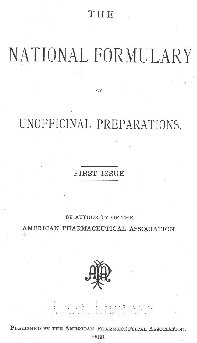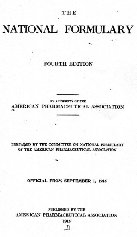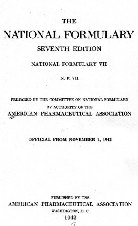The N.F.
(The National Formulary)
ABOUT THE NATIONAL FORMULARY:
The first edition of the "National Formulary" (originally named "The National Formulary of Unofficial Preparations") came out in 1888. It had been put together by a group of pharmacists, members of "The American Pharmaceutical Association," for the same exact reasons that had earlier led to the creation of the U.S. Pharmacopoeia, to standardize medical formulas.
However, instead of working in competition with the U.S.P., the National Formulary (NF) served as a complement to it. While the U.S.P. served to set standards for base drugs, the NF served to standardize the higher-level or compound drugs which made use of more than just one base drug.
The Following is taken directly from the original 1888 issue of the N. F.
"It is well known that the remedies for which the Pharmacopoeia prescribes definite standards, constitute only a limited portion of the resources of the medical profession in the treatment of the sick. Without referring to the more ephemeral preparations, or to such as are of a proprietary character, or are used by the public for self-medication, there is a large number of others, which are more or less frequently prescribed by physicians, or demanded by the public, but which are not recognized by the Pharmacopoeia, either because they were not deemed by the revisers to be of sufficient importance to be included in the official work, or because they originated subsequently to the appearance of that work, or for other reasons. Owing to the absence of an authoritative standard, many of these unofficial preparations have been, and are being made, after different formulae, and in varying strength, so that the pharmacists, particularly in the larger cities, are compelled to procure and keep on hand a variety of brands of what is intended to be one and the same preparation, to satisfy the demands of their patrons, professional or otherwise. The evils arising from this condition of things are so well known and so far-reaching in their results, that there is no need of any argument in favor of a plan which may palliate the existing evil, chiefly caused by a lack of uniformity, or the want of a common standard.
In order to bring about a practical amelioration of this state of things, a local Committee representing the College of Pharmacy of the City of New York, the Kings County Pharmaceutical Society of Brooklyn, and the German Apothecaries Society of the City of New York, several years ago published a book of formulae, comprising those which were in most frequent use in their immediate vicinity, and recommended the same to the medical profession. . . "
(Through the Years)
The National Formulary
1888 (1st Ed)

[Click on image to see more]
By 1888, when the first edition of the NF (National Formulary) came out, Cannabis was well established within the pharmaceutical community. It was used in the manufacture of bromide's, neuralgic tablets, etc. But perhaps its most interesting use was as a coloring and anti-bacterial agent in corn remedies. Its use for this purpose would continue right up into the early 1940s, when, due to political not medical pressure, it was officially removed from both the U.S. Pharmacopoeia, and the National Formulary.
The National Formulary
1898 (2th Ed)

[Click on image to see more]
Comparing the First and Second editions of the NF indicates few changes. "Mixture of Chloroform and Opium," begin replaced by a "Mixture of Chloroform and Cannabis Indica". This should not be surprising as the era, in general, was noted for little if any innovation.
The National Formulary
1906 (3th Ed)

[Click on image to see more]
Although no changes are found (either additions or subtractions) between the second and third editions of the NF -- most historians view this time period (1900 -- 1920) as the height of medical Cannabis use, with some major pharmaceutical houses such as Parke-Davis offering as many as twenty-seven different Cannabis products.
The first of the anti-Medical Cannabis laws had yet to be passed when the third edition was published.
The National Formulary
1916 (4th Ed)

[Click on image to see more]
For whatever reason, before the First World War, there was a common perception among many that Cannabis Indica (or Cannabis grown in India) somehow had superior medical properties to that of Cannabis Americana. It was no accident then that much of the Cannabis used by American pharmaceutical houses was imported from British controlled India.
However, the trade disruptions caused by the First World War literally forced America to grow many of its own botanical drug plants. Cannabis American would (by necessity) displace Cannabis Indica in its medicines.
Notice that Cannabis anti-Neuralgic pills were de-listed from the NF with seemingly nothing to replace it. This, at a time when pharmaceutical houses were increasing the number of Cannabis products, is no contradiction. The NF listed only non-patented generic drugs; those which were agreed to be tried and true.
The National Formulary
1926 (5th Ed)

[Click on image to see more]
By the time the fifth edition of the NF came out, the era of persecution was already well under way. California, as in many other things, led the nation in 1913 by including Cannabis in its poison control laws. Although its use for medicine was still allowed, the laws would begin to take their toll. Manufactures soon found themselves with an added expense as well as additional paper work. But these would be as nothing compare to the persecution that was soon to follow. Note by the included medicines, that Cannabis was still holding its own in the pharmaceutical world.
The National Formulary
1936 (6th Ed)

[Click on image to see more]
The inclusion of Cannabis Tincture to this edition of the NF was not an accident. The U.S.P. (while still recommending it in Fluidextract form), had just removed the tincture form from its latest edition. Given the late date, it is interesting to note that the medical use of Cannabis continued to be recommended by the National Formulary right up until the passage of Federal anti-Cannabis laws, which along with Federal harassment, effectively outlawed the substance.
By the time the sixth edition came out, the era of persecution was well under way. In fact only a few short years remained until Cannabis would be effectively outlawed.
Yet despite this fact groups like the American Pharmaceutical Association (publishers of the National Formulary) supported its medical use, right up until the end.
The National Formulary
1942 (7th Ed)

[Click on image to see more]
By the time the seventh edition of the National Formulary was published, Cannabis had all but disappeared from the medical world. Political pressure from the Federal Drug police had all but eliminated it. Soon its use would become only a distant memory, of interest only to medical archives and antique collectors.
WANT BETTER PICTURES: All pictures are available in CD-Rom Format from the Museum. CD-Rom is free of charge, but we do ask for a dollar donation to offset postage as well as actual cost of the media.
 Back to Appendix C |
 BACK TO MAIN INDEX PAGE |